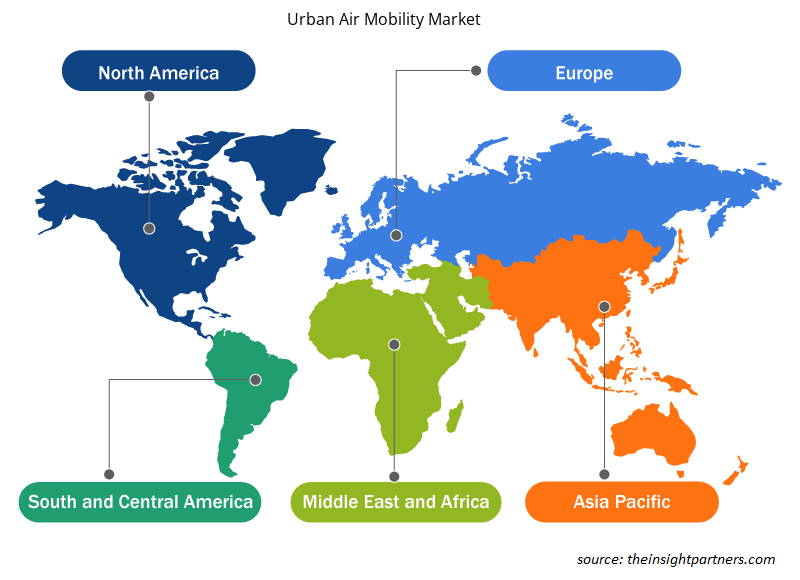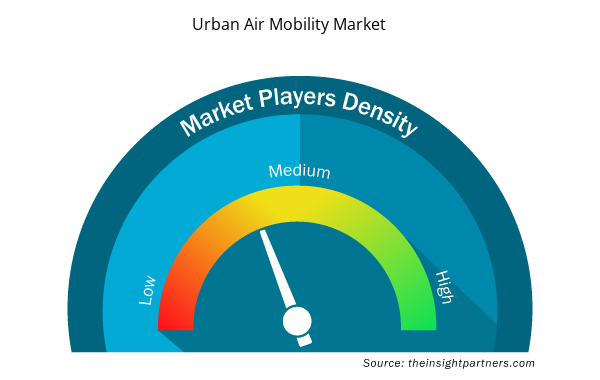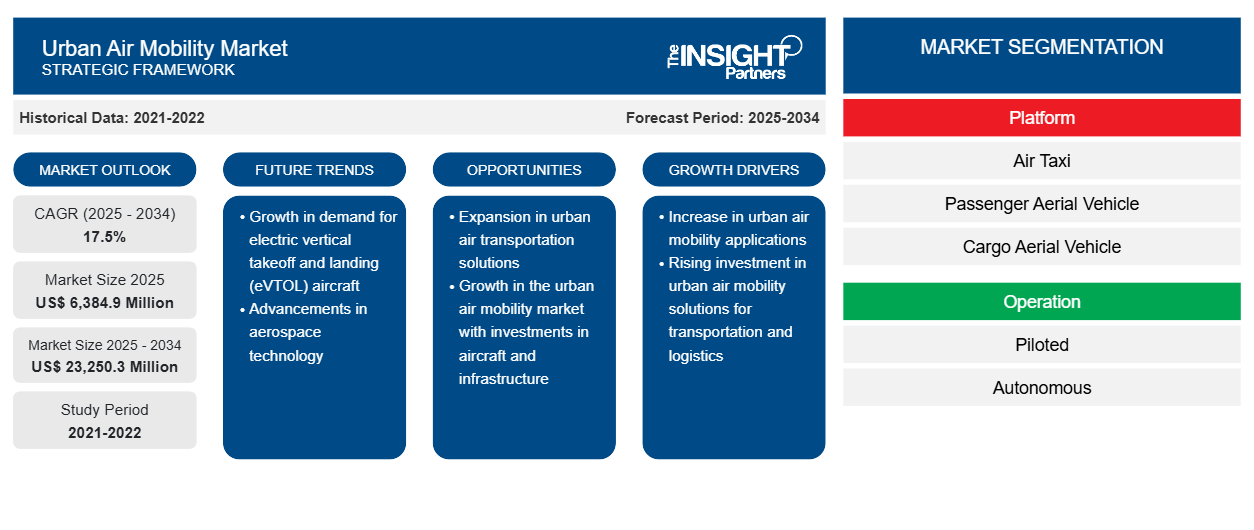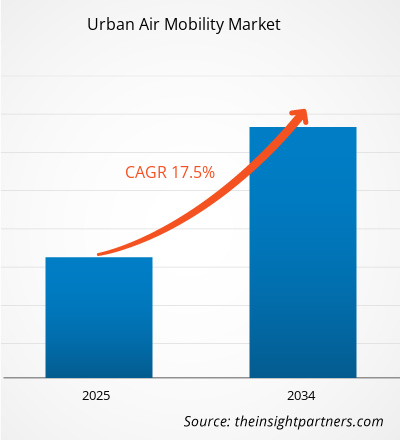Si prevede che il mercato della mobilità aerea urbana avrà un valore di 6.384,9 milioni di dollari USA nel 2025 e che raggiungerà i 23.250,3 milioni di dollari USA entro il 2034. Si prevede che il mercato della mobilità aerea urbana crescerà a un CAGR del 17,5% durante il periodo di previsione dal 2025 al 2034.
Un minimo di tre e un massimo di cinque-sei passeggeri possono viaggiare sui vettori di mobilità aerea urbana. Nelle aree rurali, più di sei passeggeri viaggiano su vettori di passeggeri a tre ruote, a seconda delle esigenze. L'aumento della congestione del traffico nelle città urbane è un fattore importante che guida la crescita del mercato. Con la crescita della popolazione urbana mondiale, la congestione del traffico ha seriamente influenzato la qualità della vita delle persone e ha avuto un impatto sulla crescita economica generale. Ad esempio, secondo INRIX (una società di analisi del traffico), un pendolare statunitense trascorre circa 41 ore nel traffico ogni anno durante i periodi di punta della congestione. Ha anche menzionato che la congestione del traffico è costata ai conducenti statunitensi circa 305 miliardi di dollari nel 2017, il che implica una media di 1.445 dollari a conducente. Inoltre, l'Agenzia per la protezione ambientale degli Stati Uniti ha stimato che un'autovettura media emette 4,7 tonnellate di anidride carbonica ogni anno. Inoltre, gli incidenti automobilistici sono aumentati, insieme all'aumento della proprietà di veicoli nei paesi in via di sviluppo come India e Cina. Secondo l'Organizzazione Mondiale della Sanità (OMS), ogni anno circa 1,25 milioni di persone muoiono in incidenti automobilistici, raggiungendo circa 3.400 decessi al giorno. Questo dato non considera i milioni di feriti subiti in incidenti non mortali.
Il mercato globale della mobilità aerea urbana è segmentato per tipo in trasporto passeggeri e trasporto merci. In base al tipo di carburante, il mercato della mobilità aerea urbana è segmentato in Diesel, Benzina, CNG, GPL ed Elettrico. La crescente domanda di mobilità aerea urbana elettrica, l'aumento della popolazione e la crescente necessità di un veicolo che aiuti nella congestione del traffico nella regione hanno sostenuto la crescita del mercato globale della mobilità aerea urbana.
Personalizza questo report in base alle tue esigenze
Riceverai la personalizzazione gratuita di qualsiasi report, comprese parti di questo report, o analisi a livello nazionale, pacchetto dati Excel, oltre a usufruire di grandi offerte e sconti per start-up e università
- Scopri le principali tendenze di mercato in questo rapporto.Questo campione GRATUITO includerà analisi di dati che spaziano dalle tendenze di mercato alle stime e alle previsioni.
Approfondimenti di mercato sulla mobilità aerea urbana
Progressi nella tecnologia dell'aviazione e della guida autonoma
I progressi nelle tecnologie aeronautiche stanno creando il potenziale per fornire un trasporto conveniente ed efficiente su richiesta per persone e merci nelle aree metropolitane. La mobilità aerea urbana (UAM) è un concetto di trasporto che ha il potenziale per ricostruire la mobilità sociale. Propone un trasporto aereo urbano altamente conveniente, accessibile e veloce, che ridurrebbe la congestione a terra scaricando l'infrastruttura di trasporto stradale esistente. L'UAM si basa sul guadagno in tecnologie come la propulsione elettrica distribuita, nuovi modelli aziendali come la condivisione di corse basata sulle applicazioni e tendenze nella produzione aerospaziale avanzata che ridurranno i costi di produzione. Aumentare il credito dell'automazione dei veicoli e delle operazioni dei veicoli autonomi sarà fondamentale per realizzare la visione dell'UAM autonomo. L'autonomia sarà necessaria per un sistema di trasporto economicamente sostenibile in grado di supportare l'elevata domanda prevista. Aumenti significativi nella maturità tecnologica di veicoli stabili, manovrabili, a decollo e atterraggio verticale (VTOL) e voli altamente automatizzati spingeranno principalmente il settore UAM.
Approfondimenti di mercato basati sulla piattaforma
Il mercato della mobilità aerea urbana è diviso in base alla piattaforma in taxi aerei, veicoli aerei per passeggeri, veicoli aerei per merci e ambulanze aeree. Sono presenti ampie applicazioni per UAM che facilitano il trasporto facile e rapido di merci e persone. Questi UAM sono ampiamente utilizzati per il trasporto di piccoli oggetti, prodotti medici e trasportano anche passeggeri. Tuttavia, queste soluzioni di mobilità hanno i loro limiti di volo a seconda del loro utilizzo. Ai veicoli UAM non è consentito volare a bassa distanza poiché colpirebbero edifici di medie e alte dimensioni né ad alta distanza per colpire compagnie aeree.
Approfondimenti di mercato basati sulle operazioni
Il mercato della mobilità aerea urbana è diviso in base al funzionamento in pilotato e autonomo. Si stima che il segmento autonomo guiderà il mercato durante il periodo di previsione, poiché gli eVTOL autonomi sono più adatti al trasporto merci e passeggeri e si prevede che saranno sempre più utilizzati per il trasporto interurbano.
Gli operatori che operano nel mercato della mobilità aerea urbana si concentrano su strategie, come iniziative di mercato, acquisizioni e lanci di prodotti, per mantenere le loro posizioni nel mercato della mobilità aerea urbana. Ecco alcuni sviluppi da parte degli operatori chiave del mercato della mobilità aerea urbana:
Nel febbraio 2020, Airbus e la Civil Aviation Authority di Singapore hanno firmato un MOU per abilitare la mobilità aerea urbana a Singapore. Questa collaborazione consentirebbe la mobilità aerea urbana nel paese.
Nel febbraio 2019 Airspace Experience Technologies ha stipulato un accordo definitivo con Spirit AeroSystems per la creazione di un velivolo certificato completamente elettrico a decollo e atterraggio verticale (eVTOL).
Approfondimenti regionali sul mercato della mobilità aerea urbana
Le tendenze regionali e i fattori che influenzano il mercato della mobilità aerea urbana durante il periodo di previsione sono stati ampiamente spiegati dagli analisti di Insight Partners. Questa sezione discute anche i segmenti e la geografia del mercato della mobilità aerea urbana in Nord America, Europa, Asia Pacifico, Medio Oriente e Africa e America meridionale e centrale.

- Ottieni i dati specifici regionali per il mercato della mobilità aerea urbana
Ambito del rapporto sul mercato della mobilità aerea urbana
| Attributo del report | Dettagli |
|---|---|
| Dimensioni del mercato nel 2025 | 6.384,9 milioni di dollari USA |
| Dimensioni del mercato entro il 2034 | 23.250,3 milioni di dollari USA |
| CAGR globale (2025 - 2034) | 17,5% |
| Dati storici | 2021-2022 |
| Periodo di previsione | 2025-2034 |
| Segmenti coperti | Per piattaforma
|
| Regioni e Paesi coperti | America del Nord
|
| Leader di mercato e profili aziendali chiave |
|
Densità degli attori del mercato della mobilità aerea urbana: comprendere il suo impatto sulle dinamiche aziendali
Il mercato della mobilità aerea urbana sta crescendo rapidamente, spinto dalla crescente domanda degli utenti finali dovuta a fattori quali l'evoluzione delle preferenze dei consumatori, i progressi tecnologici e una maggiore consapevolezza dei vantaggi del prodotto. Con l'aumento della domanda, le aziende stanno ampliando le loro offerte, innovando per soddisfare le esigenze dei consumatori e capitalizzando sulle tendenze emergenti, il che alimenta ulteriormente la crescita del mercato.
La densità degli operatori di mercato si riferisce alla distribuzione di aziende o società che operano in un particolare mercato o settore. Indica quanti concorrenti (operatori di mercato) sono presenti in un dato spazio di mercato in relazione alle sue dimensioni o al valore di mercato totale.
Le principali aziende che operano nel mercato della mobilità aerea urbana sono:
- Compagnia aerea SAS
- Scienze del volo Aurora
- Tecnologie per l'esperienza nello spazio aereo, Inc.
- Bell Textron Inc
- EHang Tecnologia Intelligente Co. Ltd
Disclaimer : le aziende elencate sopra non sono classificate secondo un ordine particolare.

- Ottieni una panoramica dei principali attori del mercato della mobilità aerea urbana
Mercato della mobilità aerea urbana – per piattaforma
- Taxi aereo
- Veicolo aereo per passeggeri
- Veicolo aereo da carico
- Ambulanza aerea
Mercato della mobilità aerea urbana – per operazione
- Pilotato
- Autonomo
Mercato della mobilità aerea urbana – per area geografica
America del Nord
- NOI
- Canada
Europa
- Francia
- Germania
- Regno Unito
- Russia
- Resto d'Europa
Resto del mondo
Mercato della mobilità aerea urbana – Profili aziendali
- Compagnia aerea SAS
- Scienze del volo Aurora
- Elicottero Bell Textron Inc.
- E-appendere
- EmbraerX
- Honeywell International Inc.
- Falco gattino
- Azienda
- Volocopter GmbH
- Analisi storica (2 anni), anno base, previsione (7 anni) con CAGR
- Analisi PEST e SWOT
- Valore/volume delle dimensioni del mercato - Globale, regionale, nazionale
- Industria e panorama competitivo
- Set di dati Excel



Report Coverage
Revenue forecast, Company Analysis, Industry landscape, Growth factors, and Trends

Segment Covered
This text is related
to segments covered.

Regional Scope
North America, Europe, Asia Pacific, Middle East & Africa, South & Central America

Country Scope
This text is related
to country scope.
Domande frequenti
Air Taxi segment led the urban air mobility market. The air taxi usage case is a door-to-door (or near-ubiquitous) ridesharing operation, which permits customers to call vertical takeoff and landing aircraft (VTOLs) to their preferred pickup locations and stipulate drop-off destinations at rooftops across the given city. These rides are on-demand and unscheduled, just like ridesharing applications the customers use in the present scenario. Similar to the air metro case, the aerial vehicles are both autonomous as well as operated by the pilots and can accommodate 2 to 5 passengers simultaneously, by an average load of 1 passenger per trip.
Advances in aviation technologies are creating the potential to provide convenient and efficient on-demand transportation for people and cargo in metropolitan areas. Urban Air Mobility (UAM) is a transportation concept that has the potential to reconstruct societal mobility. It proposes highly affordable, accessible, and fast urban air transit, which would reduce ground-based congestion by off-loading the existing roadways transportation infrastructure. Therefore, the technological advancements in the aviation industry and increasing traffic congestion are the major factors driving the growth of urban air mobility market.
The North America region will lead the Urban air mobility market in 2025 owing to the supportive government initiatives and an increasing number of companies spending rigorously on the development of urban air mobility products.
Trends and growth analysis reports related to Aerospace and Defense : READ MORE..
The List of Companies - Urban Air Mobility (UAM) Market
- Airbus SAS
- Aurora Flight Sciences
- Airspace Experience Technologies, Inc.
- Bell Textron Inc
- EHang Intelligent Technology Co. Ltd
- EmbraerX
- Jaunt Air Mobility LLC
- Kitty Hawk
- Moog Inc.
- Volocopter GmbH
The Insight Partners performs research in 4 major stages: Data Collection & Secondary Research, Primary Research, Data Analysis and Data Triangulation & Final Review.
- Data Collection and Secondary Research:
As a market research and consulting firm operating from a decade, we have published and advised several client across the globe. First step for any study will start with an assessment of currently available data and insights from existing reports. Further, historical and current market information is collected from Investor Presentations, Annual Reports, SEC Filings, etc., and other information related to company’s performance and market positioning are gathered from Paid Databases (Factiva, Hoovers, and Reuters) and various other publications available in public domain.
Several associations trade associates, technical forums, institutes, societies and organization are accessed to gain technical as well as market related insights through their publications such as research papers, blogs and press releases related to the studies are referred to get cues about the market. Further, white papers, journals, magazines, and other news articles published in last 3 years are scrutinized and analyzed to understand the current market trends.
- Primary Research:
The primarily interview analysis comprise of data obtained from industry participants interview and answers to survey questions gathered by in-house primary team.
For primary research, interviews are conducted with industry experts/CEOs/Marketing Managers/VPs/Subject Matter Experts from both demand and supply side to get a 360-degree view of the market. The primary team conducts several interviews based on the complexity of the markets to understand the various market trends and dynamics which makes research more credible and precise.
A typical research interview fulfils the following functions:
- Provides first-hand information on the market size, market trends, growth trends, competitive landscape, and outlook
- Validates and strengthens in-house secondary research findings
- Develops the analysis team’s expertise and market understanding
Primary research involves email interactions and telephone interviews for each market, category, segment, and sub-segment across geographies. The participants who typically take part in such a process include, but are not limited to:
- Industry participants: VPs, business development managers, market intelligence managers and national sales managers
- Outside experts: Valuation experts, research analysts and key opinion leaders specializing in the electronics and semiconductor industry.
Below is the breakup of our primary respondents by company, designation, and region:

Once we receive the confirmation from primary research sources or primary respondents, we finalize the base year market estimation and forecast the data as per the macroeconomic and microeconomic factors assessed during data collection.
- Data Analysis:
Once data is validated through both secondary as well as primary respondents, we finalize the market estimations by hypothesis formulation and factor analysis at regional and country level.
- Macro-Economic Factor Analysis:
We analyse macroeconomic indicators such the gross domestic product (GDP), increase in the demand for goods and services across industries, technological advancement, regional economic growth, governmental policies, the influence of COVID-19, PEST analysis, and other aspects. This analysis aids in setting benchmarks for various nations/regions and approximating market splits. Additionally, the general trend of the aforementioned components aid in determining the market's development possibilities.
- Country Level Data:
Various factors that are especially aligned to the country are taken into account to determine the market size for a certain area and country, including the presence of vendors, such as headquarters and offices, the country's GDP, demand patterns, and industry growth. To comprehend the market dynamics for the nation, a number of growth variables, inhibitors, application areas, and current market trends are researched. The aforementioned elements aid in determining the country's overall market's growth potential.
- Company Profile:
The “Table of Contents” is formulated by listing and analyzing more than 25 - 30 companies operating in the market ecosystem across geographies. However, we profile only 10 companies as a standard practice in our syndicate reports. These 10 companies comprise leading, emerging, and regional players. Nonetheless, our analysis is not restricted to the 10 listed companies, we also analyze other companies present in the market to develop a holistic view and understand the prevailing trends. The “Company Profiles” section in the report covers key facts, business description, products & services, financial information, SWOT analysis, and key developments. The financial information presented is extracted from the annual reports and official documents of the publicly listed companies. Upon collecting the information for the sections of respective companies, we verify them via various primary sources and then compile the data in respective company profiles. The company level information helps us in deriving the base number as well as in forecasting the market size.
- Developing Base Number:
Aggregation of sales statistics (2020-2022) and macro-economic factor, and other secondary and primary research insights are utilized to arrive at base number and related market shares for 2022. The data gaps are identified in this step and relevant market data is analyzed, collected from paid primary interviews or databases. On finalizing the base year market size, forecasts are developed on the basis of macro-economic, industry and market growth factors and company level analysis.
- Data Triangulation and Final Review:
The market findings and base year market size calculations are validated from supply as well as demand side. Demand side validations are based on macro-economic factor analysis and benchmarks for respective regions and countries. In case of supply side validations, revenues of major companies are estimated (in case not available) based on industry benchmark, approximate number of employees, product portfolio, and primary interviews revenues are gathered. Further revenue from target product/service segment is assessed to avoid overshooting of market statistics. In case of heavy deviations between supply and demand side values, all thes steps are repeated to achieve synchronization.
We follow an iterative model, wherein we share our research findings with Subject Matter Experts (SME’s) and Key Opinion Leaders (KOLs) until consensus view of the market is not formulated – this model negates any drastic deviation in the opinions of experts. Only validated and universally acceptable research findings are quoted in our reports.
We have important check points that we use to validate our research findings – which we call – data triangulation, where we validate the information, we generate from secondary sources with primary interviews and then we re-validate with our internal data bases and Subject matter experts. This comprehensive model enables us to deliver high quality, reliable data in shortest possible time.


 Ottieni un campione gratuito per questo repot
Ottieni un campione gratuito per questo repot